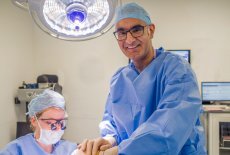Male Breast Tissue (Gynaecomastia)
Who would benefit from this procedure?
Gynaecomastia is the presence of excess breast tissue in men. Often it develops in teenagers but in many men it resolves by the end of puberty. However in a small number of men it remains and this can cause significant distress. In other men certain drugs or conditions can cause gynaecomastia.
How is it done?
In minor degrees of gynaecomastia liposuction can be used whereas surgical excision may be needed when there is more tissue.
This involves taking the excess breast tissue from under the nipple to give a flat appearance to the chest. Often the scars can be hidden at the junction of the areola and the normal skin but in severe cases this may not be possible.
Liposuction can usually be performed as a day case procedure while surgical excision normally requires an overnight stay. Both types of operation need a general anaesthetic (you are asleep).
Wounds are closed with dissolving sutures under the skin so that there is no need for stitch removal and dressings usually allow you to shower. These should stay intact until your review appointment. If liposuction has been performed then a binder will be applied to the chest and this needs to be worn continuously for 4 – 6 weeks to help the tissues to settle down.





What happens before surgery?
You should have had a full discussion about the procedure, its suitability, outcomes, complications and long-term effects with Mr Dheansa. You should be clear about the incisions to be used, the area(s) to be treated, length of stay and the costs of the procedure. Knowledge of your general health will allow assessment of fitness for an anaesthetic. If you are unclear about any aspect of your care or the procedure itself you must contact Mr Dheansa (contact details below) to clarify the situation before committing to surgery.
There are several ways to treat gynaecomastia. It is important to make sure that any causes are investigated and treated and so it is essential to have a proper assessment and examination by an experienced surgeon such as Mr Dheansa.
After the Surgery
What happens after the surgery?
Mr Dheansa will review you after your operation to make sure all is well before you go home. You will go home with painkillers and these should be taken regularly for the first week. These should make you comfortable.
Once at home you need to avoid heavy activity and sport for at least 2 weeks. You can shower with your dressings intact. If you have a binder then it is important that it is applied firmly.
Mr Dheansa will normally see you about a week after the operation to ensure you are well on the way to healing but it may take several weeks for things to fully settle down. You will have regular appointments (usually 2-3) until this time.
What should I expect post-op?
You will be sore and will need painkillers regularly. You may notice swelling and bruising which may increase over the first few days. The treated areas will be numb.
The dressings should remain intact until your appointment and you should not be doing any strenuous activity.
What can I do and not do at home?
Your dressings need to stay intact until your first appointment. Once you are healed it is best to apply Micropore tape to the scars for at least 6 weeks to help them mature and settle down as quickly as possible. In his experience Mr Dheansa feels that this is the most effective scar treatment in the early stages. You can shower and bathe as normal with the tape and simply replace it as necessary.
The chest area will benefit from twice daily massage and moisturising to help reduce swelling and encourage normal sensation to return. This should be continued for 2-3 months. Mr Dheansa will be able to advise regarding any other specific care.
Will my scars change?
All scars go through a maturing process and go through a series of changes before settling down. This process varies from person to person as well as from site to site on the same person. Generally once a wound has healed the scar will be a thin pale line. Over the ensuing 6-12 weeks the scar may become raised, pink and wider. It often
becomes itchy too. It then stabilises before slowly becoming flatter, paler and less itchy. This can take up to a further 12 months. Even after this time scars continue to improve but at a much slower rate.
Avoid sunlight on the scar for the first year to avoid it getting burnt and then subsequently dark. It is very hard to make it pale again. Mr Dheansa will advise you of any further precautions or actions if required.
Things to Consider
It is important to be prepared before and after your surgery. Here are a few things to consider about this operation.
Contour Changes
The surgery may cause changes in the shape of the breast/chest that may be less than ideal. Contour changes such as dips/uneven tissue can occur. 'Dishing' – a concave appearance of the breast can occur if too much tissue is removed. Mr Dheansa ensures that this is avoided if at all possible.
Asymmetry
Often the breasts are asymmetric (not even) before the operation and sometimes this might be the case afterwards. Mr Dheansa always makes sure that the chest is as even as possible.
Expectations
As with any procedure it is important to have appropriate expectations. Your discussions with Mr Dheansa should give you a good idea of what to expect but rarely you may feel that your chest may have been over or under corrected. It is important to have a clear idea of what you want before the surgery to avoid any disappointment.
Bruising and Swelling
This is often limited and usually resolves within a week or so.
Pain
This is usually easily controlled with painkillers and again often resolves within a week or so.
Scars
These may become thick and red. This is uncommon but often they settle down.
Sensitivity
The nipples may become sensitive. This is most likely if the nipples/areolae are not regularly massaged and moisturised.
Numbness
There may be areas of numbness.
Are there any potential risks?
There are potential risks and complications with any operation and it is important to be aware of them before committing to any surgery. You may also have particular circumstances that affect the final outcome and these will be discussed with you at your consultation.
Anaesthetic
You will be assessed for fitness for anaesthetic and providing this is appropriate the risks from general anaesthetic are low. Anaesthetic can sometimes cause a reaction though this is very rare.
Bleeding
Rarely there may be significant bleeding under the skin that does not settle. Should this occur you may have to return to theatre to control the bleeding. This should not have any long term effect should it occur.
Wound Infection
Wounds can very occasionally get infected. If you notice increasing redness, pain or an offensive odour from the wound, contact Mr Dheansa as soon as possible. If this should occur you will need to have antibiotics and frequent dressings. The wound may take longer to heal.
DVT/PE/Chest Infection
General complications such as clots in the leg or lungs (DVT or PE) are very rare as are chest infections, secondary to the anaesthetic.
Download Procedure Information
Download Consent Form
Frequently Asked Questions
How long is the operation?
About 90 minutes.
When can I shower?
SEE 'What can I do and not do at home?' section above.
How long should I keep taking pain killers?
You will often need pain killers for at least a week but everyone is different, you may need to take them for longer.
When can I go to the gym?
You should avoid the gym until about 4 weeks after the operation but check with Mr Dheansa first.
How long until the final result?
It takes about 3 months for you chest to settle.
When can I fly?
Generally it is ok to fly 2-3 weeks after the surgery but this depends of length of flight and your recovery. Check with Mr Dheansa before flying.



